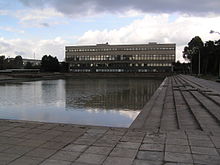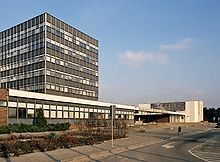- Nicolaus Copernicus University in Toruń
-
Nicolaus Copernicus University Uniwersytet Mikołaja Kopernika w Toruniu 
Latin: Universitas Nicolai Copernici Established August 24, 1945 Type Public Rector Professor Andrzej Radzimiński Students 30,835 (November 2010)[1] Location Toruń, Poland Athletics AZS UMK Affiliations EUA, Socrates-Erasmus Website www.umk.pl/en Nicolaus Copernicus University in Toruń (Polish: Uniwersytet Mikołaja Kopernika w Toruniu; UMK) is located in Toruń, Poland. It was named after Nicolaus Copernicus who was born in this town in 1473.
Contents
History
The beginnings of higher education in Toruń
The first institution of higher education in Torun, the Toruń Academic Gymnasium was founded in 1568 on Piekary street. It was one of the first universities in northern Poland. The Academic Gymnasium was the precursor to scientific and cultural life (including the first museum created in 1594) in the region. Thanks to the efforts of Heinrich Stroband, city mayor in 1594, academics in Toruń received good working conditions for teaching and research. Among his professors in the seventeenth and eighteenth centuries were meritorious scholars of Polish and Prussian history, authors of textbooks and papers from various disciplines of humanities, and associates scientific journals.
The establishment of the university in a modern form began in the nineteenth century. During the partitions of Poland the Prussian government planned to create a University of Theology, which was to include faculties of law and economics, unfortunately this project did not materialise.
In the interwar period the city authorities of Toruń again sought to establish a university. Soon after the annexation of Pomerania to the reborn Poland in 1920, a new phase of efforts to develop the university began. Even before 1920 the Supreme People's Council had considered the proposal to establish higher educational institutions in the Polish territories annexed by Prussia at the University of Gdansk and in Toruń. However, political developments and the uncertain future of Pomerania prompted the council's leadership to accept the December 1918 resolution of the Sejm to overlook Toruń as a location for a new university and instead go ahead with the development of a university in Poznań.
In 1920, the first declaration requesting the establishment of a university was put forward in November by the National Workers Party whose members chose Toruń-born Nicolaus Copernicus to be the patron of the University. For this purpose a number of educational societies, such as the Baltic Institute (later transferred to Gdynia, and then to Gdańsk) amongst others, were established in the town.
Finally in 1938 it was decided to set up the Nicolaus Copernicus University in Toruń as a subsidiary of Poznań's Adam Mickiewicz University; work was to start at the beginning of 1940. This program, however, was interrupted by World War II. It was not until 1947, (two years after the creation of the Nicolaus Copernicus University) that prof. Karol Gorski revealed that before the outbreak of World War II there was an approved plan to open Poznań University long-distance division in Toruń in 1940, to teach the humanities and theology.
School Authorities
- Rector: Prof. Andrzej Radzimiński
- Vice-Rector for Education: Prof. Danuta Janicka
- Vice-Rector for Research and International Relations: Prof. Andrzej Tretyn
- Vice-Rector for Students Affairs: Prof. Witold Wojdyło
- Vice-Rector for Economics and Development: Prof. Włodzimierz Karaszewski
- Vice-Rector for Collegium Medicum: Prof. Małgorzata Tafil-Klawe
- Vice-Rector for Computerisation: Prof. Grzegorz Jarzembski
- Director of Administration: Dr Paweł Modrzyński
Staff
Staff / Year 2003[2] 2004[3] 2006[4] 2008[5] 2009[6] 2010[1] Professors 373 475 485 497 474 485 Habilitated doctors 85 111 107 131 121 123 Senior lecturers 576 805 852 964 995 1,027 Teachers (total) 1,427 2,009 2,077 2,244 2,203 2,221 Other staff 1,663 2,102 2,059 2,180 2,149 2,119 Total staff 3,090 4,111 4,136 4,424 4,352 4,340 Number of students
Students / Year 2003[2] 2004[3] 2006[4] 2008[5] 2009[6] 2010[1] Full-time day students 17,455 20,622 20,688 20,575 21,575 22,725 Extramural students 14,501 16,680 17,178 10,641 9,247 8,110 Postgraduate students 3,889 4,526 2,673 2,487 2,517 2,275 Total 35,845 41,828 40,539 33,703 33,339 33,110 Levels of study offered by institution
- Shorter/intermediate university level qualifications
- First main university level final qualifications
- Advanced/postgraduate study
- Doctorate
- Higher/post doctorate
Diplomas and degrees
- Licentiate (3 years undergraduate degree. Equivalent to Bachelor of Science or Bachelor of Art)
- Engineer (3 or 3.5 years technical degree. Equivalent to Bachelor of Engineering)
- Magister (5 years degree equivalent to a course-based Masters programme)
- Ph.D. Degree
- Habilitated Doctor Degree.
International cooperation
- Universita degli Studi di Padova – Italy
- Universita degli Studi di Ferrara – Italy
- Carl von Ossietzky Universität Oldenburg – Germany
- Otto Friedrich Universität Bamberg, – Germany
- Universität Rostock – Germany
- Ernst Moritz Arndt Universität Greifswald – Germany
- Bundeswehr Universität München – Germany
- Université d’Angers – France
- The Nottingham Trent University – United Kingdom
- Dominican University – USA
- Cranfield University – United Kingdom
Faculties
- Faculty of Biology and Earth Sciences
- Faculty of Chemistry
- Faculty of Economic Sciences and Management
- Faculty of Education Sciences
- Faculty of Fine Arts
- Faculty of Health Sciences
- Faculty of History
- Faculty of Humanities
- Faculty of Languages
- Faculty of Law and Administration
- Faculty of Mathematics and Computer Science
- Faculty of Medicine
- Faculty of Pharmacy
- Faculty of Physics, Astronomy and Applied Informatics
- Faculty of Theology
Notable alumni
- Zbigniew Herbert, (1924-1998), poet
- Maciej Konacki, (1972-), astronomer
- Zbigniew Nowek, (1959-), head of Polish Intelligence Agency
- Andrzej Person, (1951-), senator and noted sports journalist
- Aleksander Wolszczan, (1946-), astronomer
See also
- The Nicolaus Copernicus University Library
- The Nicolaus Copernicus University Press
- Nicolaus Copernicus University Polar Station
- Kujawsko-Pomorska Digital Library
Coordinates: 53°01′06″N 18°34′20″E / 53.01833°N 18.57222°E
Notes
- ^ a b c Janik, Agnieszka (2010-11-30). "General informations 2010". http://bip.uni.torun.pl/ViewBIP?exec=dokument&dok=356. Retrieved 2011-05-02.
- ^ a b Janik, Agnieszka (2003-12-31). "General informations 2003". http://bip.uni.torun.pl/ViewBIP?exec=dokument&dok=1. Retrieved 2011-05-02.
- ^ a b Janik, Agnieszka (2004-11-24). "General informations 2004". http://bip.uni.torun.pl/ViewBIP?exec=dokument&dok=51. Retrieved 2011-05-02.
- ^ a b Janik, Agnieszka (2006-03-31). "General informations 2006". http://bip.uni.torun.pl/ViewBIP?exec=dokument&dok=143. Retrieved 2011-05-02.
- ^ a b Janik, Agnieszka (2008-11-30). "General informations 2008". http://bip.uni.torun.pl/ViewBIP?exec=dokument&dok=269. Retrieved 2011-05-02.
- ^ a b Janik, Agnieszka (2009-11-30). "General informations 2009". http://bip.uni.torun.pl/ViewBIP?exec=dokument&dok=309. Retrieved 2011-05-02.
External links
Categories:- Universities and colleges in Poland
- Nicolaus Copernicus University in Toruń
Wikimedia Foundation. 2010.






